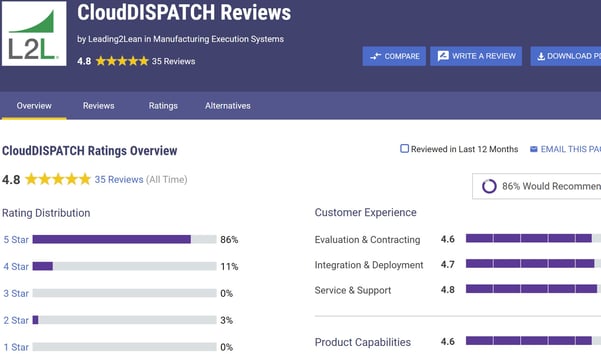Table Of Contents
It's clear that the digital revolution has transformed manufacturing in many ways. We now have countless systems that gather and process tons of data. It’s happening in every department from your Accounting folks to your Zero Scrap group, and everywhere in between: Maintenance, Manufacturing, Logistics, Quality, Shipping and Transportation. And a few that are nearer and dearer to our hearts as well - Human Resources, benefits, payroll, pension administrators.
This is really good news! From A to Z and everywhere in between, all of these different software packages were implemented with the primary objective of managing or resolving a particular issue. That's the good news part: most of them did just that, serving that purpose, addressing the one issue. There's also some not quite as good news.
The less than really good news part is that most of those systems were put in place to deal with one specific objective. And while they often performed that task well enough, companies have been left with dozens of fragmented systems. Like looking at a great big puzzle without the big picture by its side so you know what everything will look like when all the pieces are in place.
Wouldn’t it be great if all of these systems spoke the same language and could talk with each other? Let's explore how cloud solutions can help bridge the gap between disparate systems and leverage your ability to analyze data and optimize your operations.
Harmonizing Disparate Manufacturing Systems
As manufacturing plants expand their digital workplaces, disparate systems have been adopted to support increasingly digitized production processes. These systems include:
- Maintenance
- Safety
- Quality (scrap, traceability, inspection and SPC)
- Document storage
- Production tracking
- Employee training and skills documentation
Each piece is instrumental to any overall production process. But, due to the fragmented reality when so many of them coexist simultaneously rather than harmoniously, they are often under-leveraged and, therefore, underperform.
While manufacturers strive for a common plant floor system, language, and data reporting structure, the belief is that this harmony is very difficult to achieve, so the aspiration is abandoned. It’s a daunting task for the people on the floor to become experts with every system. They are asked to provide the raw data for these systems, which they routinely do. Unfortunately, what occurs all too often, is that most of these data inputters have no visibility to what happens after they have provided this data. Surprisingly, more than one 'Brand X' Software Expert has shared with me that they are not entirely sure what happens to all that data either. Perhaps not that surprising after all.
What does this mean in the real manufacturing world? How much effort would you expend, let alone ask your associates to put forth, when you can't even see what's being done with all this data? For one thing, it means the likelihood of redundancy is very high. Different people inputting the same data into different systems. This factor alone is the epitome of inefficiency and waste, the very things we strive to minimize or eliminate. How about that, "Let's work together as a Team!", atmosphere you've been working so tirelessly to achieve? The frustration that results when people feel like their efforts are futile erodes far too much of your hard earned team environment. Much like not being able to catch the fish you can't see, this makes it difficult to measure and improve your production metrics in a meaningful way. Out of sight, out of mind.
How Cloud Manufacturing Software Is Resolving This Issue
There are resolutions to this situation, made possible through the Cloud. While most other verticals, including the healthcare industry and government, have embraced the Cloud and this amazing technology, many manufacturers are late adopters. Consider these:
- Cloud solutions offer the best opportunity to overlay and link disparate manufacturing systems. Cloud solutions provide the framework to bring these all together.
- Cloud solutions offer better security and lower risk than homegrown systems. Cloud Service Providers such as Apple, Amazon and Microsoft, work 24/7 to identify external security issues and automatically update their solutions. Otherwise, the responsibility falls on internal IT resources.
- Cloud systems are less costly. They simply require less of an IT footprint than other alternatives. With cloud solutions, you remove the need for outside vendors to take up semi-permanent residency in your facility.
8 Questions To Ask Cloud Manufacturing Software Providers
When evaluating any Cloud-based maintenance or production management solution provider, manufacturers should elevate their expectations by asking them these 8 questions:
- Can it streamline audit processes?
- Will it simplify training and create a full digital history of training? Including all requirements, evidence of satisfactory completion, equipment qualifications, and certifications?
- Will the deployment require a lengthy and costly IT project plan?
- Is a “rip and replace” of existing ERP, MES, and CMMS systems necessary?
- Must we always sacrifice user-friendly and intuitive UI to obtain better data? Manufacturers know that a lack of good UI in any system will create manual workarounds, which defeats a project’s objectives..
- Does it return positive impacts on core manufacturing metrics such as Operational Availability, Cost-of-Product and OEE, all while delivering a solid ROI?
- Does the solution fit the reality of the plant floor and the way maintenance and production departments need to operate? (Or was it built by people that don't understand the plant floor...)
- Finally, does it increase or decrease plant floor employee engagement on problem solving? These folks are the real experts. Not harnessing their experience and hands-on knowledge is truly a waste.
L2L's Is Highest Rated Cloud Manufacturing Software
Now that you have some questions and tools to help you make the right decision, here's a couple reasons why L2L can be your trusted partner.
Leading2Lean is proud to have the distinction of receiving the highest overall rating of 4.8 out of a possible score of 5.0 among all Manufacturing Execution Systems. *Source: Gartner Peer Insights, "Voice of the Customer", Gartner, Inc. April 2020.

Leading2Lean is also the highest ranked Cloud Manufacturing Software solution / MES provider among that group for Customer Support. This rating comes from actual users of L2L, the people who build product and manage manufacturing operations just like yours.
Why should the highest customer satisfaction rating matter to you? And why should it be a factor in your decision making? It is human nature to provide negative feedback first, almost instinctively. "No news is good news", is what we all believe on some level. This ranking means that our customers went out of their way to provide positive feedback for the benefit of others seeking a Cloud Manufacturing Software solution.
As you're asking your potential software providers those eight questions we reviewed earlier, keep these ratings in mind. You want to use the best possible Cloud Manufacturing Software available. And you know from your own previous experience how critical it is to have outstanding customer support as well as technical expertise.
The technology is here now to harmonize all of your critical systems into one cloud solution. Maximize value and leverage your manufacturing support systems across all levels of your organization. It’s never been easier, as cloud solutions provide a secure, agile, and dynamic method that will have you wishing you had switched sooner.
Are you interested in learning more? Schedule a call with our team today.




